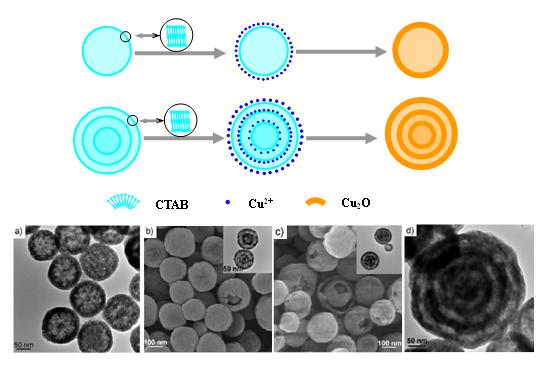Significant Progress in Synthesis of multi-shelled hollow spheres by SICCAS
| |
|
|
| Recently, Prof. Wenzhong Wang and co-workers from Shanghai Institute of Ceramics Chinese Academy of Sciences have made a great progress in the synthesis of multi-shelled hollow Cu2O spheres by using multilamellar vesicles as templates. Although this route is theoretically possible, it has never been realized before. They successfully synthesized unilammellar and mutlilamellar vesicles and utilized them as soft templates to prepare the Cu2O hollow structures (see the above figures). Based on the different structures of the vesicles, they obtained single-shelled (Fig. a), double-shelled (Fig. b), triple-shelled (Fig. c), and even quadruple-shelled (Fig. d) hollow spheres. Previously, vesicle-templated route could just be used to prepare single-shelled hollow spheres. Their route presents an important development on the vesicle-templated synthesis. Moreover, these novel multi-shelled hollow spheres will be of interest to wide researchers and may bring new properties and applications including catalysis and carriers. The results have been published in “Angewandte Chemie International Edition” (2007, 46, 1489-1492). The referees highly valued their work: “The multi-layered spheres are novel and the electron evidence showing the multi-layers is convincing. The materials described in the manuscript are new, should be of interest to a wide audience and have potential application…”; “The authors report several very interesting shell morphologies in this manuscript. The synthesis route is indeed simple and able to give homogeneous products for multi-shelled Cu2O…” Furthermore, Prof. Wang and colleagues have also made progresses in novel high active visible light-driven photocatalysts, shape-controllable synthesis of nanomaterials and corresponding growth mechanisms, such as porous spheres, superstructures and related photocatalytic properties etc.. These results have been published in J. Phys. Chem. B, Cryst. Growth Des., Nanotechnology, J. Mol. Catal. A-Chem., Appl. Catal. A-Gen., etc.. These works were supported by the Chinese Academy of Sciences and the Shanghai Institute of Ceramics under the program for Recruiting Outstanding Overseas Chinese and Natural Science Foundation of China. |




